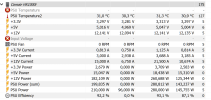I have read that there are some undocumented behaviour about corsair iCue or Corsair Link internal calculations, but I don't think that the problem I am reporting is related to this.
According to HWiNFO64 description PSU Efficiency is the ratio "PSU Power Sum"/"PSU Power".
Well this ratio seems to be not correct for two reasons
1) quite often the numerator is bigger than denominator. (ok, I know, this can be due to by incorrect measuring of input and output power BUT IN ANY CASE THIS MUST lead to a > 100 % efficency, but this never happen
2) the ratio calculated is wrong even if the numerator is smaller than denominator
Some examples of recorded values
PSU Power Sum 125,472W
PSU Power 124,000W
PSU Efficiency 89,9%
Instead the efficiency should be 101,18%
PSU Power Sum 119,089W
PSU Power 124,000W
PSU Efficiency 89,3%
Instead the efficiency should be 96,039%
According to HWiNFO64 description PSU Efficiency is the ratio "PSU Power Sum"/"PSU Power".
Well this ratio seems to be not correct for two reasons
1) quite often the numerator is bigger than denominator. (ok, I know, this can be due to by incorrect measuring of input and output power BUT IN ANY CASE THIS MUST lead to a > 100 % efficency, but this never happen
2) the ratio calculated is wrong even if the numerator is smaller than denominator
Some examples of recorded values
PSU Power Sum 125,472W
PSU Power 124,000W
PSU Efficiency 89,9%
Instead the efficiency should be 101,18%
PSU Power Sum 119,089W
PSU Power 124,000W
PSU Efficiency 89,3%
Instead the efficiency should be 96,039%




